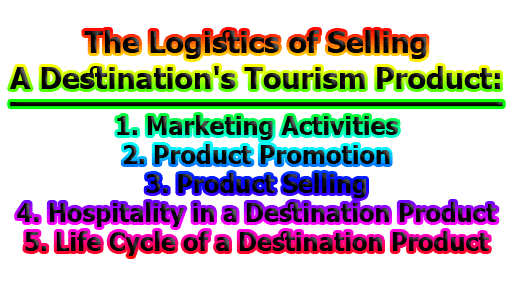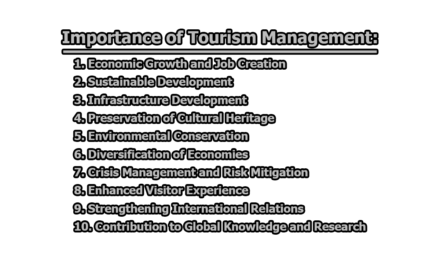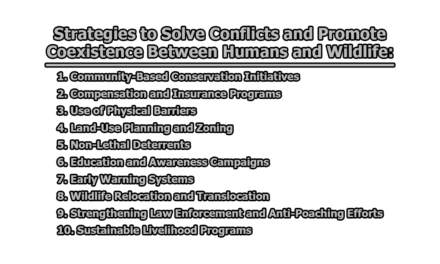The Logistics of Selling a Destination’s Tourism Product:
Tourism is an important economic activity for many destinations around the world. It involves a range of businesses, organizations, and individuals that work together to create, promote, and sell a destination’s tourism product. This product can include a wide range of attractions, services, and experiences, such as natural and cultural attractions, accommodation, food and beverage, transportation, and entertainment. Selling a destination’s tourism product requires careful planning, coordination, and execution of marketing activities, product promotion, product selling, and hospitality. In addition, destinations must also manage the life cycle of their tourism product, from product development to decline in product sales. This article will discuss the logistics of selling a destination’s tourism product, focusing on the five key areas.
1. Marketing Activities: Marketing activities are an essential component of selling a destination’s tourism product. Marketing activities aim to create awareness, interest, and desire among potential customers. The following are some of the marketing activities that destinations can use to promote their tourism product:
1.1 Advertising: Advertising is one of the most common and effective marketing activities for promoting a destination’s tourism product. Advertising can take various forms, including print ads, TV commercials, radio spots, and online ads. Destinations must carefully target their advertising efforts to reach the right audience and convey a compelling message that highlights the destination’s unique features and benefits.
1.2 Public Relations: Public relations (PR) is another important marketing activity that can help destinations build their reputation, credibility, and visibility. PR involves using various communication channels to create positive publicity and manage relationships with the media, stakeholders, and customers. PR can include media tours, press releases, social media campaigns, and events.
1.3 Sales Promotion: Sales promotion involves offering incentives or discounts to encourage customers to purchase a destination’s tourism product. Sales promotions can include special deals, package offers, loyalty programs, and contests. Sales promotion can be an effective way to attract new customers and retain existing ones.
1.4 Direct Marketing: Direct marketing involves reaching out to potential customers directly through the mail, email, or other forms of communication. Direct marketing can be personalized and targeted, which can increase its effectiveness. Direct marketing can include newsletters, brochures, email campaigns, and telemarketing.
2. Product Promotion: Product promotion is the process of highlighting the unique features, benefits, and value of a destination’s tourism product to potential customers. Product promotion can be done through various channels, such as advertising, PR, sales promotion, and direct marketing. The following are some of the product promotion strategies that destinations can use:
2.1 Branding: Branding is the process of creating a unique identity, image, and reputation for a destination’s tourism product. Branding can help differentiate the destination from its competitors, create a sense of loyalty among customers, and increase the perceived value of the product. Branding can include logos, slogans, taglines, and other visual and verbal elements.
2.2 Online Presence: An online presence is critical for promoting a destination’s tourism product in today’s digital age. Destinations must have a website that showcases their product, provides relevant information, and allows customers to make bookings and payments. Destinations must also have a presence on social media platforms, such as Facebook, Twitter, and Instagram, to engage with customers, share content, and build relationships.
2.3 Events and Festivals: Events and festivals can be an effective way to promote a destination’s tourism product and attract visitors. Events and festivals can showcase the destination’s cultural, artistic, or natural heritage, and provide unique experiences for visitors. Events and festivals can include music festivals, food fairs, sporting events, and cultural celebrations.
2.4 Tour Packages: Tour packages are pre-arranged itineraries that combine various tourism products, such as accommodation, transportation, and activities, into a single package. Tour packages can make it easier for customers to plan and book their trips, and can offer cost savings and convenience. Tour packages can be promoted through advertising, direct marketing, and online platforms.
3. Product Selling: Product selling is the process of converting potential customers into actual customers by offering them a range of options, such as pricing, availability, and customization. Product selling requires good communication skills, knowledge of the product, and the ability to negotiate and close sales. The following are some of the product-selling strategies that destinations can use:
3.1 Pricing Strategies: Pricing strategies are important for product selling because they can affect the perceived value of the product and the willingness of customers to purchase it. Destinations can use various pricing strategies, such as differential pricing, dynamic pricing, and value-based pricing, depending on market conditions, competition, and customer preferences.
3.2 Reservation Systems: Reservation systems are critical for product selling because they allow customers to make bookings and payments easily and securely. Reservation systems can be integrated with a destination’s website or other online platforms and can provide real-time availability, pricing, and confirmation. Reservation systems can also provide data and analytics that can help destinations optimize their sales and marketing efforts.
3.3 Customer Service: Customer service is essential for product selling because it can influence the customer’s overall experience and satisfaction with the product. Destinations must provide good customer service throughout the customer’s journey, from pre-arrival to post-departure. Customer service can include personalized recommendations, responsive communication, and prompt resolution of issues and complaints.
4. Hospitality in a Destination Product: Hospitality is a critical component of a destination’s tourism product because it can enhance the customer’s experience and satisfaction, and create a sense of loyalty and advocacy. Hospitality involves providing a welcoming, friendly, and comfortable environment for customers, and anticipating and meeting their needs and expectations. The following are some of the hospitality strategies that destinations can use:
4.1 Accommodation Standards: Accommodation standards are important for hospitality because they can affect the customer’s comfort, safety, and hygiene. Destinations must ensure that their accommodation options meet the minimum standards, such as cleanliness, comfort, and safety features. Destinations can also offer additional amenities and services, such as Wi-Fi, room service, and concierge, to enhance the customer’s experience.
4.2 Food and Beverage Offerings: Food and beverage offerings are important for hospitality because they can provide customers with a taste of the local cuisine and culture, and offer them a range of options that cater to their preferences and dietary needs. Destinations must offer a variety of food and beverage options, including local specialties, international cuisine, and healthy choices. Destinations must also ensure that their food and beverage offerings meet quality and safety standards, and provide good value for money.
4.3 Customer Engagement: Customer engagement is critical for hospitality because it can create a sense of connection and relationship between the destination and the customer. Destinations can engage with customers through various channels, such as social media, email, and in-person interactions. Destinations can provide personalized recommendations, respond to feedback and queries, and offer special perks and privileges to loyal customers.
5. Life Cycle of a Destination Product: The life cycle of a destination’s tourism product refers to the stages that the product goes through from development to decline in sales. The life cycle can be divided into four stages: product development, product introduction, product maturity, and decline in sales. Destinations must manage the life cycle of their tourism product by continuously innovating, improving, and adapting to changing market conditions and customer preferences. The following are some of the strategies that destinations can use for each stage of the life cycle:
5.1 Product Development: Product development is the initial stage of the life cycle, where destinations identify market opportunities and develop new tourism products that cater to the needs and preferences of target customers. Product development involves research, planning, and investment, and requires collaboration between various stakeholders, such as government agencies, private companies, and community groups. The following are some of the strategies that destinations can use for product development:
5.1.1 Market Research: Market research is critical for product development because it helps destinations understand market demand, customer behavior, and competition. Destinations can conduct market research through surveys, focus groups, and data analysis, and use the findings to identify gaps and opportunities in the market. Market research can also help destinations prioritize their investments and resources.
5.1.2 Stakeholder Engagement: Stakeholder engagement is important for product development because it helps destinations build partnerships and collaborations with various stakeholders, such as tour operators, accommodation providers, and local communities. Stakeholder engagement can help destinations leverage the expertise and resources of stakeholders, and ensure that the tourism product is aligned with the needs and interests of the local community.
5.1.3 Product Innovation: Product innovation is essential for product development because it helps destinations differentiate their tourism product from competitors and create a unique value proposition for customers. Product innovation can involve new features, services, and experiences, as well as new technologies, such as virtual reality and augmented reality. Destinations must also ensure that their product innovation is sustainable and responsible, and does not harm the natural and cultural resources of the destination.
5.2 Product Introduction: Product introduction is the second stage of the life cycle, where destinations launch their new tourism product and promote it to the market. Product introduction involves a range of marketing and sales activities and requires careful planning and execution. The following are some of the strategies that destinations can use for product introduction:
5.2.1 Advertising and Promotion: Advertising and promotion are important for product introduction because they can create awareness and interest among target customers. Destinations can use various advertising and promotion channels, such as print media, digital media, and outdoor media, as well as events and exhibitions. Destinations must also ensure that their advertising and promotion messages are aligned with the product’s value proposition and customer needs.
5.2.2 Sales and Distribution: Sales and distribution are critical for product introduction because they allow customers to access and purchase the product easily and conveniently. Destinations must establish partnerships and agreements with various sales and distribution channels, such as travel agents, online travel agencies, and tour operators. Destinations must also ensure that their sales and distribution channels provide accurate and timely information, and offer good customer service.
5.2.3 Customer Feedback and Monitoring: Customer feedback and monitoring are important for product introduction because they allow destinations to evaluate the product’s performance and make necessary improvements. Destinations can collect customer feedback through surveys, reviews, and social media, and use the findings to identify the strengths and weaknesses of the product. Destinations must also monitor the market trends and competition, and adjust their marketing and sales strategies accordingly.
5.3 Product Maturity: Product maturity is the third stage of the life cycle, where destinations reach a peak in sales and profitability, and face increased competition and market saturation. Product maturity requires destinations to maintain and enhance the product’s quality, value, and relevance, and to explore new market segments and customer segments. The following are some of the strategies that destinations can use for product maturity:
5.3.1 Quality Control and Improvement: Quality control and improvement are critical for product maturity because they ensure that the product meets or exceeds customer expectations and maintains its competitiveness. Destinations must regularly assess and monitor the product’s quality and standards, and make necessary improvements and upgrades. Destinations must also ensure that their products comply with the regulations and standards of the destination.
5.3.2 Customer Relationship Management: Customer relationship management (CRM) is important for product maturity because it helps destinations build loyal and repeat customers, and maintain a positive reputation in the market. Destinations must establish and maintain a database of customer information, and use it to personalize and customize their marketing and sales strategies. Destinations must also provide excellent customer service, and address customer complaints and feedback promptly and effectively.
5.3.3 Diversification and Innovation: Diversification and innovation are essential for product maturity because they help destinations expand their customer base and stay competitive in the market. Destinations must identify new market segments and customer segments, and develop new products or modify existing products to meet their needs and preferences. Destinations must also embrace new technologies and trends, and adapt their marketing and sales strategies accordingly.
5.4 Decline in Product Sales: Decline in product sales is the fourth and final stage of the life cycle, where destinations experience a decline in demand and profitability, and face challenges such as changing customer needs and preferences, increased competition, and external shocks such as natural disasters or pandemics. Decline in product sales requires destinations to make tough decisions, such as whether to invest in product rejuvenation or phase out the product. The following are some of the strategies that destinations can use for decline in product sales:
5.4.1 Rejuvenation or Rebranding: Rejuvenation or rebranding is an option for destinations facing decline in product sales, where they invest in product improvements or modifications to make the product more attractive to customers. Rejuvenation or rebranding can involve new features, services, and experiences, as well as new marketing and sales strategies. Destinations must ensure that their rejuvenation or rebranding efforts are aligned with the current market trends and customer needs.
5.4.2 Phasing Out or Replacement: Phasing out or replacement is another option for destinations facing decline in product sales, where they gradually withdraw the product from the market and replace it with a new product. Phasing out or replacement can be a difficult decision, and requires careful planning and execution. Destinations must ensure that their phasing out or replacement efforts do not harm the destination’s reputation or local community.
5.4.3 Strategic Partnerships and Collaborations: Strategic partnerships and collaborations are important for destinations facing a decline in product sales, as they can help destinations leverage the expertise and resources of other stakeholders, and explore new market opportunities. Strategic partnerships and collaborations can involve joint marketing and sales initiatives, product development, and knowledge sharing. Destinations must ensure that their partnerships and collaborations are aligned with their strategic goals and objectives.
In conclusion, the logistics of selling a destination’s tourism product involve various stages of the product life cycle, from product development to decline in product sales. Destinations must use a range of marketing and sales strategies, such as market research, advertising and promotion, sales and distribution, customer feedback and monitoring, quality control, and improvement, customer relationship management, diversification and innovation, rejuvenation or rebranding, phasing out or replacement, and strategic partnerships and collaborations. Destinations must also ensure that their tourism products are sustainable, responsible, and aligned with the needs and interests of the local community.
References:
- Buhalis, D., & Laws, E. (2001). Tourism distribution channels: practices, issues, and transformations. Continuum.
- Buhalis, D. (2000). Marketing the competitive destination of the future. Tourism Management, 21(1), 97-116.
- Kotler, P., Bowen, J. T., & Makens, J. C. (2014). Marketing for hospitality and tourism. Pearson Education Limited.
- Mazanec, J. A., Wöber, K. W., & Zins, A. H. (2007). Tourism destination marketing and management: Collaborative strategies. CABI.
- Morrison, A. M., Anderson, D. A., & O’Leary, J. T. (1995). Tourism principles and practice (2nd ed.). Longman.
- Pizam, A., & Mansfeld, Y. (Eds.). (2000). Tourism, crime and international security issues. John Wiley & Sons.
- Prideaux, B. (2005). A framework for evaluating rural tourism in developed regions. Journal of sustainable tourism, 13(6), 629-644.
- Ritchie, B., & Crouch, G. I. (2003). The competitive destination: A sustainable tourism perspective. CABI.
- Tribe, J. (2010). The indiscipline of tourism. Annals of tourism research, 37(4), 1357-1376.
- McKercher, B., & du Cros, H. (2002). Cultural tourism: The partnership between tourism and cultural heritage management. Routledge.
- Jamal, T. B., & Getz, D. (Eds.). (1995). Collaboration in tourism businesses and destinations. CABI.
- Sigala, M. (2004). The strategic use of integrated marketing communications by destination marketing organizations. Journal of travel & tourism marketing, 17(2-3), 179-194.
- Wang, D., Li, X. R., & Hu, B. (2015). Destination management organizations in China: A review of the literature. Journal of Destination Marketing & Management, 4(1), 3-12.
- Zopiatis, A., Theocharous, A. L., & Constantin, P. (2014). Destination branding and visitor loyalty: A case study of a Cyprus destination. Journal of Destination Marketing & Management, 3(2), 82-90.
- Weaver, D. B. (2006). Sustainable tourism: Theory and practice. Butterworth-Heinemann.
- Cooper, C., Fletcher, J., Fyall, A., Gilbert, D., & Wanhill, S. (2018). Tourism: Principles and Practice (6th ed.). Pearson.
- Morrison, A. M. (2013). Marketing and managing tourism destinations. Routledge.
- Page, S. J., & Connell, J. (2014). Tourism: A modern synthesis. Routledge.

Assistant Teacher at Zinzira Pir Mohammad Pilot School and College










